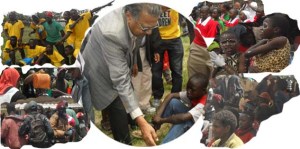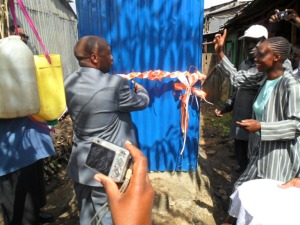Street Children: Dr. Manu Chandaria
Can you imagine asking 200,000 questions to 40,000,000 people? This might seem impossible. Meet Dr. Manu Chandaria, Kenyan Industrialist who is currently the leading advocate for the plight and rights of street children in Kenya. I met him and his brother at International Day for Street Children on 12.04.2014 at St. Teresa’s Girls Secondary School. This day has been set aside for ‘giving voice to street children so their rights cannot be ignored.
Globally it is estimated that there are 100 million street children who live and work on the streets under very difficult circumstance however debate abound about the figures. But one thing is certainly is clear, the number of street children have been raising and more importantly street families especially in Kenya. Kenya is estimated to have between 200,000 – 300,000 street children. To witness the problem in Nairobi, one needs to walk around Globe Cinema Roundabout either in the morning or evening.
There are only two people in Kenya, late Fr. Arnold Grol and Dr. Manu Chandaria who have dedicated time and resources to help street children passionately and genuinely. Dr. Manu Chandaria speaks about street children with ease and one would easily conclude him to be an expert in this field.
The usual picture of street children in Kenya is that of dirty clothes, glue sniffing, unruly, rough and hunger. But behind all these, we have normal human beings who are positive about life. I attended the celebration to the mark the International Day for Street Children and had the opportunity to listen to Dr. Manu Chandaria ask, “What can 40 million Kenyans do to address the plight of 200,000, street children? For Dr. Manu Chandaria OBE & OBS, a famous industrialist he sees potential in street children and that is why during the event, he mingled so easily with the street children.
Dr. Manu Chandaria would like to see an environment where street children are treated with dignity and facilitated to be part of wider society since he believes that they have potential to make a positive contribution in making Kenya a better place.
I spoke to more than 50 street children from different ‘bases’ and they all expressed desire to live in a decent environment where they can access education, training, medical care and jobs. Some Non Governmental Organizations have managed to organize themselves to provide services such as vocational skills training, health, food, clothing and shelter but this is not enough. While the problem of street children is a worldwide concern, our government can do better to address problems faced by 300,000 who live in inhuman condition. If we can invest billions for roads, railways and drilling oil in Turkana then what about investing in our own children? The 47 County Governments in Kenya can be pushed to allocate special funds to address issues related to street children.
Street children problem is human problem which can only be solved by human beings. If Kenya had so many Dr. Manu Chandaria then we would have been able to provide decent life to our children on the street.
Why Map Urban Informal Settlement?
Informal settlements are generally ‘unrecognised’ in many urban settings. In years that have passed places like Mathare, Kibera and Mukuru were not visible on the net. With the advent of participatory mapping and Open Street Map platform, it became practical for communities that are hidden from rest of the world to be visible.
Open Street Map has now become the alternative to showing what most governmens would not want highlighted due to ‘policies’. My experience of mapping Mathare was filled with anxious moments and too many questions by the village elders. Elders in 2010 looked at mapping as a way of demacating land and plot allocation and regulization.
Upon mapping mapping Mathare; boundries and resource distribution in the community became evident and this was followed by meaningful discussions with how the community looks like and what is not there.
Local leaders, NGOs and community based groups were not left behind. The map has been become a source of inspiration and motivation to proper community development. The disparities in allocation of resources by the politicians and local administration became evident and discussions ensued.
The power of people mapping their communities can no longer be ignored as it brings out the true picture of the community.
Thanks to Open Street Map, the underprivileged, invisible can now be corrected and made visible- Simon
Celebrating Mathare Valley Blog
The month of September 2011 will always be remembered as important in the history of matharevalley blog. This was the month Map Kibera Trust visited Mathare Valley looking for possible partners to be involved in community mapping. The first organization was Cooperazione Internazionale (COOPI), an Italian international NGO working Mathare in the sector of urban development and food security targeting poor neighbourhoods.
Primoz, a Slovenian introduced the concept of community mapping using GPS. The participants were to be trained in use of GPS and computers. Plan Kenya office was to fund the training. The idea was simply to train youth on how they could develop a ‘talking map’.
A team from Kibera was brought down to Mathare and the process started. More than 150 youths from Mathare, Mabatini, Huruma, Kia Maiko and Mathare North expressed interest. Since the programme was purely voluntary, no lunch or transport; with time most youth had dropped out. The best thing that happen was about youth who remained. Ever since the team has continued to map their own community and share information with local leaders and NGOs working in Mathare.
However in December 2010, the Mathare team took a adopted a another approach from Map Kibera Trust. While Map Kibera team preferred using website and Voice of Kibera to tell thei stories, Mathare Team explored other options I started blogging since it does not require funding to run. Hence www.matharevalley.wordpress.com was born in December 2010.
The idea to start to Matharevalley blog was purely decided by people from Mathare me. This was to answer fears that if Plan Kenya pulls out, how will the team continue sharing information about community on continous basis. I thank all readers and organizations who have taken time to read the blog. – Simon
Right to Sanitation-Mathare
On 28 July 2010 United Nations General Assembly declared, “the right to safe and clean drinking water and sanitation as a human right that is essential for the full enjoyment of life and all human rights.” Kenya being a member of UN I believe Mathare people are too.
Looking at the situation in Mathare, it is sometimes too much to bear for the residents. The government officials are overburden with situation due to lack of equipment and little investment by the local authorities. This has forced youth groups to organize themselves to bridge lack of resources by the government to address water, environment and sanitation challenges in the slum.
Today (11/5/2011), I was part of a team that saw the launching of new type of toilets by Plan Kenya through partnership with local groups such as Community Cleaning Services, Tunaweza Youth Group and MANYGRO from Mathare.
The event was attend by Plan representatives from Uganda, Tanzania, Ethiopia, Indonesia, Bangladesh, Netherlands, Plan Australia and Kenya office among other countries.
It is now apparent to the resident that the right to clean water and adequate sanitation has to be led by the people and not by government officials. The joy exhibited by the residents during the launch was a demonstration of their determination to make it a reality and an enjoyable right.
Having access to clean water and sanitation is no-longer a matter of health but people appreciating their environment and respecting their surrounding.
The water, environment and sanitation is the next biggest employer in the slums. Nearly all toilets employ more than ten people per toilet. All water points are managed by people who ran them on daily basis. Tunaweza Youth Group in Mashimoni has been able to construct a bio toilet. Through this venture, they have a meeting hall and are in the process of harnessing gas to generate electricity and sell to the community.
The Map Mathare group has been mapping water and sanitation points to establish the real situation. It is through generating information that the community can engage either development partners and government top facilitate more development projects. Mathare team has managed to map nearly all the open drainage in small section. This will help identify points where there broken sewer and water pipes.
Plan Kenya and Plan Australia have managed to help the community achieve their potential to enjoy their to water and sanitation. – Simon

